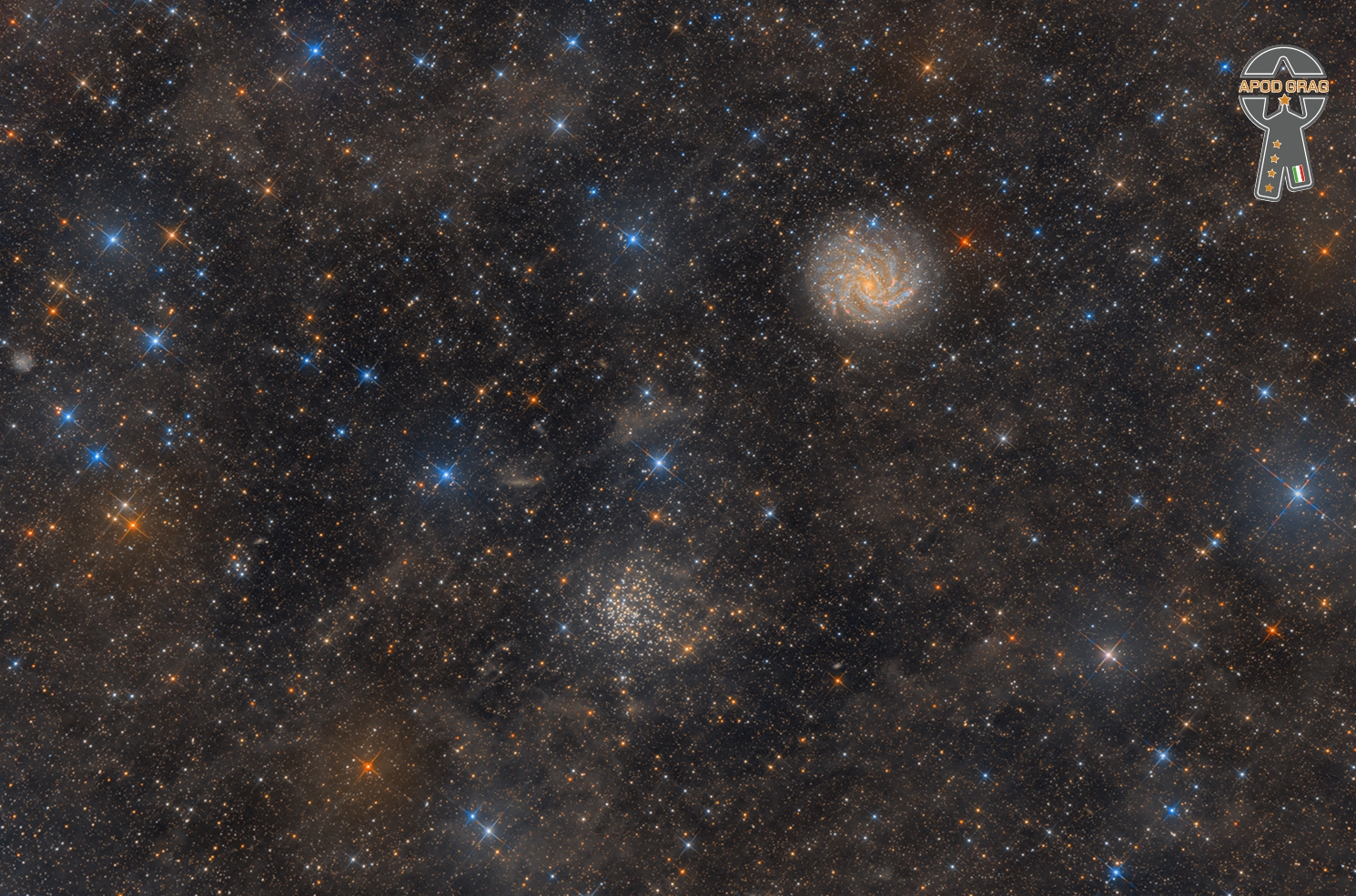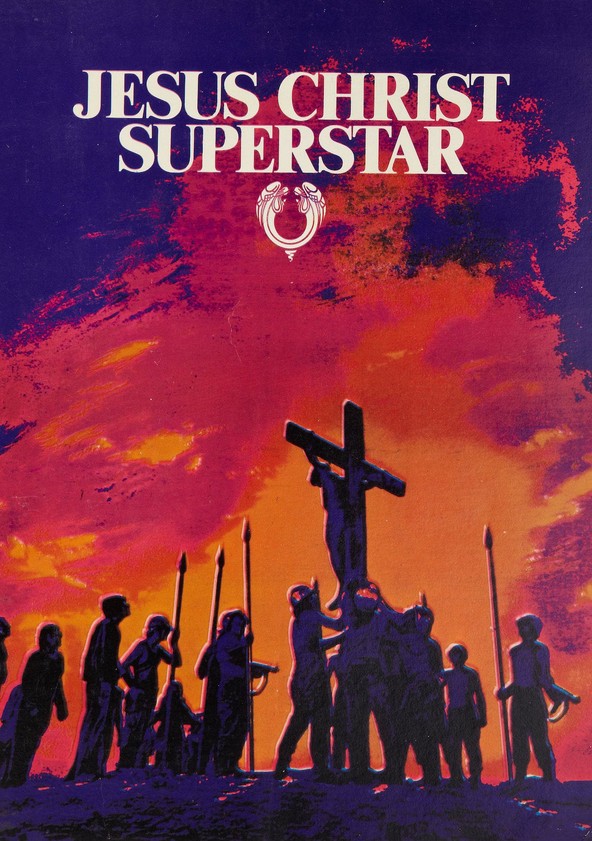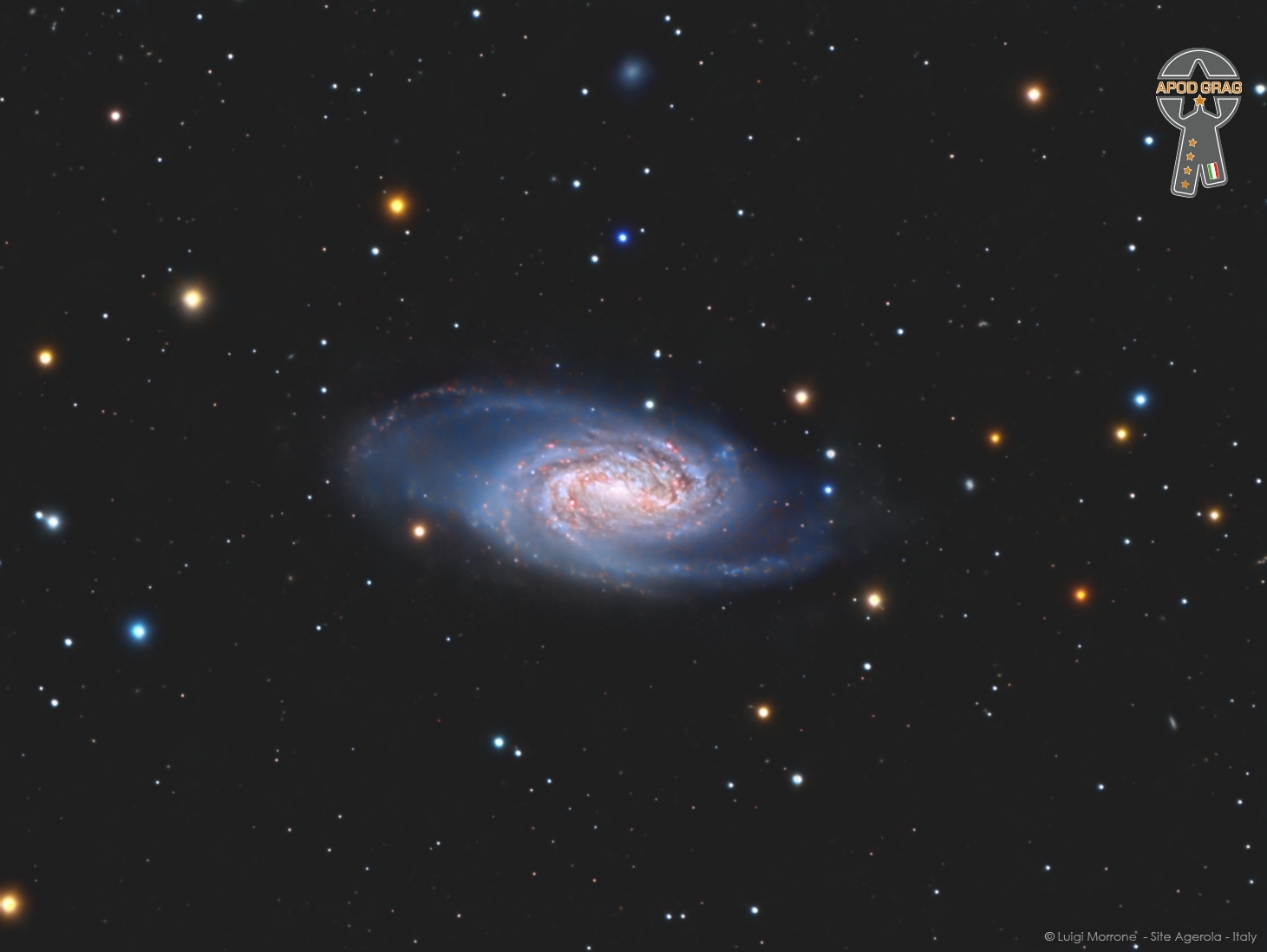Blog
Rare are the spiral galaxies that we see exactly from the front. The spiral galaxy NGC6946 located in the constellation Cepheus is about 10 million light-years away.
She hides behind the curtain of stars formed by the Milky Way which crosses the constellation of Cepheus. Its orange central bulb is made up of old stars while the blue
young star clusters dominate in the spiral arms. Red reveals the presence of areas where stars are born.
The activity is so inetnse that one calls this galaxy, the galaxy of the fireworks.

Commander Cody and His Lost Planet Airmen were an American country rock band founded in 1967. The group’s leader and co-founder was pianist and vocalist George Frayne IV, alias Commander Cody (born July 19, 1944 in Boise, Idaho, died September 26, 2021 in Saratoga Springs, New York)
The band’s style mixed country, rock and roll, Western swing, rockabilly, and jump blues together on a foundation of boogie-woogie piano. They were among the first country rock bands to take their cues less from folk rock and bluegrass and more from the rowdy barroom country of the Ernest Tubband Ray Price style. The band became known for marathon live shows.
Alongside Frayne, the classic lineup was Billy C. Farlow (b. Decatur, Alabama) on vocals and harmonica; John Tichy (b. St. Louis, Missouri) on guitar and vocals; Bill Kirchen (Kirchen was born in Bridgeport, Connecticut, June 29, 1948 but grew up in Ann Arbor, Michigan) on lead guitar; Andy Stein(b. August 31, 1948 in New York City) on saxophone and fiddle; “Buffalo” Bruce Barlow (b. December 3, 1948 in Oxnard, California) on bass guitar; Lance Dickerson (b. October 15, 1948 in Livonia, Michigan, died November 10, 2003, in Fairfax, California) on drums; and Steve “The West Virginia Creeper” Davis (b. July 18, 1946 in Charleston, West Virginia), followed by Bobby Black, on pedal steel guitar.
more...Philip Upchurch (born July 19, 1941) is an American jazz and blues guitarist.
Upchurch started his career working with the Kool Gents, the Dells, and the Spaniels, before going on to work with Curtis Mayfield, Otis Rush, and Jimmy Reed. (His association with Kool Gents member Dee Clark would continue, including playing guitar on Clark’s 1961 solo hit “Raindrops“.) He then returned to Chicago to play and record with Woody Herman, Stan Getz, Groove Holmes, B.B. King, and Dizzy Gillespie.
more...Carmell Jones (July 19, 1936 – November 7, 1996) was an American jazz trumpet player.
Jones was born in Kansas City, Kansas, United States. He started piano lessons at age five, and trumpet lessons at age seven. His first professional work was with Kansas City musicians Nathan Davis, Cleanhead Vinson and Frank Smith. He moved to California in 1961, and worked as a studio musician for several years, including in the orchestras for two movie soundtracks, Seven Days In May and The Manchurian Candidate, the latter starring Frank Sinatra. He released two albums as a leader for Pacific Jazzat this time, while recording as a sideman with Bud Shank, Onzy Matthews, Curtis Amy, Harold Land, and Gerald Wilson. He toured with Horace Silver in 1964-65, and was on Silver’s seminal 1965 Blue Note album Song for My Father. In 1965, he moved to Germany where he lived for 15 years, working with Paul Kuhn and the SFB Big Band (Sender Freies Berlin) from 1968 to 1980. There he worked with musicians such as Milo Pavlovic, Herb Geller, Leo Wright, Rudi Wilfer and Eugen Cicero. Jones returned to the US in 1980, working as a teacher and appearing at local clubs in Kansas City. He released one additional album as a leader in 1982 entitled Carmell Jones Returns, on the Revelation label. Jones died of heart failure on November 7, 1996, in Kansas City at the age of 60.
https://www.youtube.com/watch?v=vwVHnao7J2Q&list=PL0q2VleZJVEm6I7Gvtltt2SUTsSdmfGJT
more...Alan Warren Haig (July 19, 1922 – November 16, 1982) was an American jazz pianist, best known as one of the pioneers of bebop.
Haig was born in Newark, New Jersey and raised in nearby Nutley. In 1940, he majored in piano at Oberlin College. He started performing with Dizzy Gillespie and Charlie Parker in 1945, and performed and recorded under Gillespie from 1945 to 1946, as a member of Eddie Davis and His Beboppers in 1946 (also featuring Fats Navarro), and the Eddie Davis Quintet in 1947, under Parker from 1948 to 1950, and under Stan Getz from 1949 to 1951. The Gillespie quintet, which included Haig, recorded four 78 r.p.m. sides for Guild Records in May 1945 which are regarded as the first recordings to demonstrate all elements of the mature bebop style. He was part of the nonet on the first session of Miles Davis‘ Birth of the Cool.
more...This intriguing observation from the NASA/ESA Hubble Space Telescope shows a gravitationally lensed galaxy with the long-winded identification SGAS J143845+145407. Gravitational lensing has resulted in a mirror image of the galaxy at the centre of this image, creating a captivating centrepiece. Gravitational lensing occurs when a massive celestial body — such as a galaxy cluster — causes a sufficient curvature of spacetime for the path of light around it to be visibly bent, as if by a lens. Appropriately, the body causing the light to curve is called a gravitational lens, and the distorted background object is referred to as being “lensed”. Gravitational lensing can result in multiple images of the original galaxy, as seen in this image, or in the background object appearing as a distorted arc or even a ring. Another important consequence of this lensing distortion is magnification, allowing astronomers to observe objects that would otherwise be too far away or too faint to be seen. Hubble has a special flair for detecting lensed galaxies. The telescope’s sensitivity and crystal-clear vision allow it to see faint and distant gravitational lenses that cannot be detected with ground-based telescopes because of the blurring effect of Earth’s atmosphere. Hubble was the first telescope to resolve details within lensed images of galaxies, and is capable of imaging both their shape and internal structure. This particular lensed galaxy is from a set of Hubble observations that take advantage of gravitational lensing to peer inside galaxies in the early Universe. The lensing reveals details of distant galaxies that would otherwise be unobtainable, and this allows astronomers to determine star formation in early galaxies. This in turn gives scientists a better insight into how the overall evolution of galaxies has unfolded.

Brian Albert Gordon Auger (born 18 July 1939) is an English jazz rock and rock music keyboardist who specialises in the Hammond organ. Auger has worked with Rod Stewart, Tony Williams, Jimi Hendrix, John McLaughlin, Sonny Boy Williamson, and Eric Burdon. He incorporated jazz, early British pop, R&B, soul music, and rock into his sound. He has been nominated for a Grammy Award.
In 1965, Auger played on “For Your Love” by The Yardbirds as a session musician. That same year, Auger formed the group The Steampacket with Long John Baldry, Julie Driscoll, Vic Briggs, and Rod Stewart. Due to contractual problems there were no official recordings made by the band; nevertheless, nine tracks were laid down for promotional use in late 1965 and released as an LP in 1970 in France on the BYG label. They were released on a CD by Repertoire Records in 1990 (licensed from Charly Records) as well as 12 live tracks from Live at the Birmingham Town Hall, February 2, 1964. Stewart left in early 1966 and soon thereafter the band broke up.
more...
Mthutuzeli Dudu Pukwana (18 July 1938 – 30 June 1990) was a South African saxophonist, composer and pianist (although not known for his piano playing).
Dudu Pukwana was born in Walmer Township, Port Elizabeth, South Africa. He grew up studying piano in his family, but in 1956 he switched to alto saxophoneafter meeting tenor saxophone player Nikele Moyake. In 1962, Pukwana won first prize at the Johannesburg Jazz Festival with Moyake’s Jazz Giants (1962 Gallo/Teal). In his early days he also played with Kippie Moeketsi. Chris McGregor then invited him to join the pioneering Blue Notes sextet, where he played along with Mongezi Feza, Nikele Moyake, Johnny Dyani and Louis Moholo. Although the Blue Notes are often considered McGregor’s group, Pukwana was initially the principal composer and all the group members had pivotal roles.
more...Jalacy J. “Screamin’ Jay” Hawkins (July 18, 1929 – February 12, 2000) was an American singer-songwriter, musician, actor, film producer, and boxer. Famed chiefly for his powerful, operatic vocal delivery and wildly theatrical performances of songs such as “I Put a Spell on You“, he sometimes used macabre props onstage, making him an early pioneer of shock rock. He received a nomination for the Independent Spirit Award for Best Supporting Male for his performance in the 1989 indie film Mystery Train. Hawkins was born and raised in Cleveland, Ohio. At the age of 18 months, Hawkins was put up for adoption and shortly thereafter was adopted and raised by Blackfoot Indians. Hawkins studied classical piano as a child and learned guitar in his 20s.
Federico Arístides Soto Alejo (June 30, 1930 – February 4, 2008), better known as Tata Güines, was a Cuban percussionist, bandleader and arranger. He was widely regarded as a master of the conga drum, and alongside Carlos “Patato” Valdés, influential in the development of contemporary Afro-Cuban music, including Afro-Cuban jazz.[1] He specialized in a form of improvisation known as descarga, a format in which he recorded numerous albums throughout the years with Cachao, Frank Emilio Flynn, Estrellas de Areito, Alfredo Rodríguez and Jane Bunnett, among others. In the 1990s he released two critically acclaimed albums as a leader: Pasaporte and Aniversario. His composition “Pa’ gozar” has become a standard of the descarga genre.
more...Theatre 55 presents the third installment of JCSS today at Caponi Art Park 5pm matinee. Featuring Van Nixon as Jesus with music by Raymond Berg, Jamie Carter, Lyra Olson and mick laBriola.

NGC 2903 is a spiral galaxy about 20 million light-years away in the constellation Leo. The galaxy shows an exceptional rate of star formation activity near its center, also bright in radio, infrared, ultraviolet, and x-ray bands. Just a little smaller than our own Milky Way, NGC 2903 is about 80,000 light-years across.

Chico Freeman (born Earl Lavon Freeman Jr.; July 17, 1949) is a modern jazz tenor saxophonist and trumpeter and son of jazz saxophonist Von Freeman. He began recording as lead musician in 1976 with Morning Prayer, won the New York Jazz Award in 1979 and earned the Stereo ReviewRecord of the Year in 1981 for his album The Outside Within.
He was born in Chicago, Illinois, United States. Freeman was introduced to the trumpet by his brother Everett, who found a trumpet in the family basement. Freeman began playing, inspired by artists such as Miles Davis. He went to Northwestern University in 1967 with a scholarship for mathematics and played the trumpet in the school, but did not begin playing the saxophone until his junior year. After practicing eight to ten hours per day and trying out for the saxophone section, Freeman quickly changed his major to music, and graduated in 1972. By that time he was proficient in saxophone, trumpet, and piano.
more...July 17th 1945-2008 Percussionist, Producer, Composer, Solo Artist
One man’s trash is another man’s treasure. Nothing could be truer for Norman Hedman and the discovery of his first hand drum, a conga, he rescued from a Brooklyn garbage can. A native of the West Indies, Hedman instinctively knew how to repair the conga at age 12 and has been playing music ever since.
Background
Today, the music of this first call percussionist, solo artist, producer, and composer, gathers multi-genre music connoisseurs around the globe. Attracted to Hedman’s number one hits with broad appeal, audiences discover his passion for accessible music. “I think music heals, and Tropique’s music falls into that category; whether you’re a teen or 80 years old,” says Hedman. From Latin Jazz to R&B and Pop, Hedman’s commercial recognition is widespread. His extensive product pedigree includes a variety of hit projects:
Music Accomplishments
Number One Hits
Songs in A Minor, Alicia Keys (5 GRAMMY ® Awards)
Fear of Flying, Mya (Platinum Album)
I Ain’t Movin’, Des�’ree (Multi-Platinum Album)
Brass Construction, Brass Construction (Gold)
Walkin – the Line, Brass Construction (Gold)
Movie Soundtracks
Ali “Fight”
Shaft “Rock With U”
Dr Doolittle 2 “Rearview Mirror”
Benjamin Alexander Riley Jr. (July 17, 1933 – November 18, 2017) was an American jazz drummer known for his work with Thelonious Monk, as well as Alice Coltrane, Stan Getz, Eddie “Lockjaw” Davis, Ahmad Jamal, and as a member of the group Sphere. During the 1970s and 1980s he was a member of the New York Jazz Quartet.
Benjamin Alexander Riley Jr. was born in Savannah, Georgia, on July 17, 1933, and at the age of four moved with his family to New York City.
“Riley performed with Randy Weston, Sonny Stitt, Stan Getz, Junior Mance, Kenny Burrell, Eddie “Lockjaw” Davis–Johnny Griffin (1960–1962), Ahmad Jamal, Billy Taylor, and Ray Bryant. He then spent 1964 to 1967 in Thelonious Monk‘s quartet. After Monk, he played with Alice Coltrane(intermittently between 1968 and 1975), Ron Carter (1975–1977), Jim Hall (1981), and the bands the New York Jazz Quartet (1970s and 1980s) and Sphere. He also played frequently with pianist Abdullah Ibrahim.
more...Joseph Albert Morello (July 17, 1928 – March 12, 2011) was an American jazz drummer best known for serving as the drummer for pianist Dave Brubeck, as part of the Dave Brubeck Quartet, from 1957 to 1972, including during the quartet’s “classic lineup” from 1958 to 1968, which also included alto saxophonist Paul Desmond and bassist Eugene Wright. Morello’s facility for playing unusual time signatures and rhythms enabled that group to record a series of albums that explored unusual time signatures. The most notable of these was the first in the series, the 1959 album Time Out, which contained the hit songs “Take Five” and “Blue Rondo à la Turk“. In fact, “Take Five”, the album’s biggest hit (and the first jazz single to sell more than one million copies) was specifically written by Desmond as a way to showcase Morello’s ability to play in 5
4 time.
Besides playing with Brubeck, Morello also served as an accompanist for other musicians, including Marian McPartland, Tal Farlow and Gary Burton, and recorded his own albums as well. He received numerous accolades during his life, including being named the best drummer by Down Beatmagazine five years in a row.
more...More Posts
- Duane Allman Day
- Meredith Monk Day
- World Music with Toufic Farroukh & Yasmine Hamdan
- Daily Roots with Creator
- The Cosmos with NGC 2467
- Kenny Werner Day
- Tommy Dorsey Day
- World Music with Lee Young-Shin
- Daily Roots with Billy Joe Morgan
- The Cosmos with Aurora Borealis
- Cindy Blackman Day
- Don Cherry Day
- Hank Ballard Day
- World Music with Tone Hulbækmo
- Daily Roots with Clarence Parks
- The Cosmos with 30 Doradus
- Gene Clark Day
- Phil Parnell Day
- David Amram Day
- World Music with Tinariwen